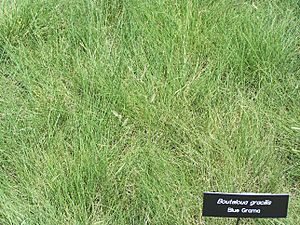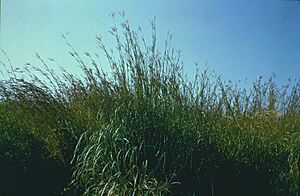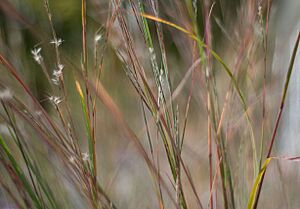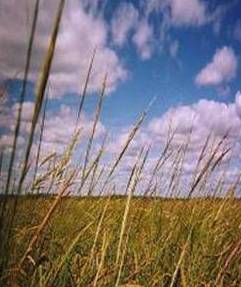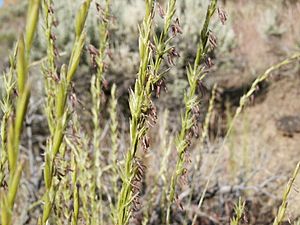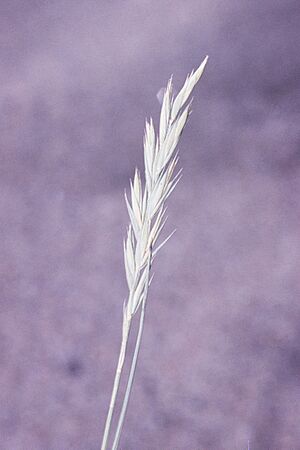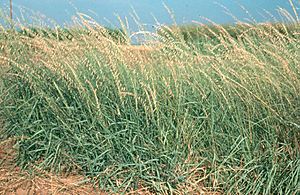List of U.S. state grasses facts for kids
The United States is a big country, and each state has its own special symbols. These symbols help represent the state's unique history, nature, and culture. Just like a state might have a state bird or a state flower, many states also have an official state grass.
These grasses are chosen for different reasons. Sometimes, they are very common in that state. Other times, they are important for farming, wildlife, or the environment. Choosing a state grass helps people learn about the plants that grow around them. It also shows how important these plants are to the state's natural beauty and economy.
Why Do States Choose a Grass?
Choosing a state grass is a way to celebrate the natural world. It helps people recognize important plants. These grasses often play a big role in the state's ecosystem. They can provide food for animals. They also help prevent soil from washing away. Sometimes, a grass is chosen because it has been important to the state's history or agriculture.
Meet Some State Grasses
Many states have picked a specific grass as their official symbol. Let's look at some of these interesting plants and why they were chosen.
California's Purple Needlegrass
California's state grass is the Purple needlegrass. Its scientific name is Nassella pulchra. This grass was adopted in 2004. It is a native grass that grows naturally in California. It is known for its beautiful purple-tinged seeds. This grass is very important for the state's grasslands. It provides food and shelter for many animals.
Colorado's Blue Grama
The state of Colorado chose Blue grama as its official grass in 1987. Its scientific name is Bouteloua gracilis. Blue grama is a very common grass in the western United States. It is known for being tough and able to grow in dry places. It is also a good food source for grazing animals. New Mexico also shares Blue grama as its state grass.
Illinois's Big Bluestem
In Illinois, the official state prairie grass is Big bluestem. It was adopted in 1989. Its scientific name is Andropogon gerardii. This grass is very tall and can grow up to 10 feet high. It is a key plant in the tallgrass prairies of the Midwest. Big bluestem helps create rich soil. It also provides a home for many prairie animals. Missouri also chose Big bluestem as its state grass.
Kansas's Little Bluestem
Kansas picked Little bluestem as its state grass in 2010. Its scientific name is Schizachyrium scoparium. This grass is smaller than Big bluestem. It is also a very important part of prairie ecosystems. Little bluestem turns a lovely reddish-brown color in the fall. It is a tough grass that can grow in many different soils. Nebraska also has Little bluestem as its state grass.
Minnesota's Wild Rice
Minnesota's state grain is Wild rice. It was adopted in 1977. Its scientific name is Zizania aquatica. While many state grasses are for grazing, wild rice is special. It is a type of grass that grows in water. Its seeds are harvested and eaten as a grain. Wild rice has been an important food source for Native American tribes for centuries.
Montana's Bluebunch Wheatgrass
Montana's state grass is Bluebunch wheatgrass. It was adopted in 1973. Its scientific name is Agropyron spicatum. This grass is very common in the western rangelands. It is an important food source for livestock and wildlife. Bluebunch wheatgrass is known for being very hardy. It can survive in dry conditions. Washington state also recognizes Bluebunch wheatgrass.
Nevada's Indian Ricegrass
Nevada chose Indian ricegrass as its state grass in 1977. Its scientific name is Oryzopsis hymenoides. This grass is well-suited for dry, desert environments. Its seeds were traditionally gathered and eaten by Native American tribes. Indian ricegrass is important for stabilizing sandy soils. Utah also shares Indian ricegrass as its state grass.
North Dakota's Western Wheatgrass
North Dakota's state grass is Western wheatgrass. Its scientific name is Pascopyrum smithii. This grass is very common across the Great Plains. It is a cool-season grass, meaning it grows best in cooler temperatures. Western wheatgrass is important for grazing animals. South Dakota and Wyoming also have Western wheatgrass as their state grass.
Oklahoma's Indian Grass
Oklahoma's state grass is Indian grass. It was adopted in 1972. Its scientific name is Sorghastrum nutans. This tall grass is a key part of the tallgrass prairie. It has beautiful, feathery seed heads. Indian grass provides good forage for animals. South Carolina also chose Indian grass as its state grass.
Texas's Sideoats Grama
Texas picked Sideoats grama as its state grass in 1971. Its scientific name is Bouteloua curtipendula. This grass is very common throughout Texas. It gets its name because its seeds hang from one side of the stem. Sideoats grama is an excellent forage grass. It is also very attractive in natural landscapes.
Wisconsin's Corn
Wisconsin's state grain is Corn. It was adopted in 1989. Its scientific name is Zea mays. Like wild rice, corn is a type of grass. It is one of the most important crops in the world. Corn is grown for food, animal feed, and many other products. Wisconsin is a major corn-producing state.
Images for kids
See also



